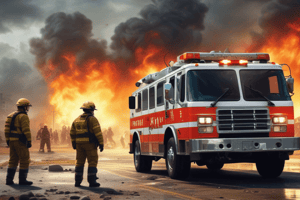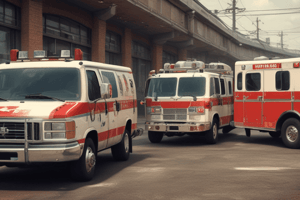Podcast
Questions and Answers
What is the primary goal of the Incident Command System (ICS)?
What is the primary goal of the Incident Command System (ICS)?
- To limit the number of incidents that can occur simultaneously
- To establish a hierarchy of command based on seniority
- To reduce the number of emergency responders at the scene
- To make the best use of resources to manage the environment and treat patients (correct)
What is the recommended supervisor-to-worker ratio in the ICS?
What is the recommended supervisor-to-worker ratio in the ICS?
- One supervisor for fifteen subordinates
- One supervisor for ten subordinates
- One supervisor for five subordinates (correct)
- One supervisor for three subordinates
What is the purpose of sections in the ICS organizational structure?
What is the purpose of sections in the ICS organizational structure?
- To coordinate with other responders
- To oversee a specific functional area (correct)
- To provide emergency medical services
- To manage a specific geographic area
When are branches typically established in the ICS?
When are branches typically established in the ICS?
What is the role of the incident commander in the ICS?
What is the role of the incident commander in the ICS?
What is the purpose of the general staff in the ICS?
What is the purpose of the general staff in the ICS?
What is the role of the liaison officer in the ICS?
What is the role of the liaison officer in the ICS?
What is the purpose of emergency operations centers?
What is the purpose of emergency operations centers?
When should responders use the ICS?
When should responders use the ICS?
What refers to any situation that overwhelms your resources?
What refers to any situation that overwhelms your resources?
How many patients are involved in a mass-casualty incident (MCI)?
How many patients are involved in a mass-casualty incident (MCI)?
In a disaster, what can constitute a disaster if there is only one EMS unit available?
In a disaster, what can constitute a disaster if there is only one EMS unit available?
Which agreement is between neighboring EMS systems to respond when local resources are insufficient?
Which agreement is between neighboring EMS systems to respond when local resources are insufficient?
Which is NOT an example mentioned for mass-casualty incidents?
Which is NOT an example mentioned for mass-casualty incidents?
How should an EMT manage an event with a large number of patients?
How should an EMT manage an event with a large number of patients?
What enables an EMT to do the greatest good for the greatest number of people at an incident?
What enables an EMT to do the greatest good for the greatest number of people at an incident?
Which branch will an EMT typically work within under the Incident Command System (ICS)?
Which branch will an EMT typically work within under the Incident Command System (ICS)?
What may an EMT be asked to do under the Incident Command System (ICS)?
What may an EMT be asked to do under the Incident Command System (ICS)?
In what situation can an incident be considered a disaster?
In what situation can an incident be considered a disaster?
What are the two important underlying principles of the National Incident Management System (NIMS)?
What are the two important underlying principles of the National Incident Management System (NIMS)?
Why is maintaining interoperability crucial in NIMS?
Why is maintaining interoperability crucial in NIMS?
Which component of the NIMS focuses on mechanisms to describe, inventory, track, and dispatch resources during and after an incident?
Which component of the NIMS focuses on mechanisms to describe, inventory, track, and dispatch resources during and after an incident?
What is the main purpose of the Incident Command System (ICS) mentioned in the text?
What is the main purpose of the Incident Command System (ICS) mentioned in the text?
Why is unity of effort considered an important guiding principle in NIMS?
Why is unity of effort considered an important guiding principle in NIMS?
What is the purpose of maintaining standardization in NIMS?
What is the purpose of maintaining standardization in NIMS?
Which component of NIMS focuses on effective communication, information sharing, and interoperability during domestic incident management?
Which component of NIMS focuses on effective communication, information sharing, and interoperability during domestic incident management?
What concept refers to the ability of agencies from different backgrounds to communicate with each other in NIMS?
What concept refers to the ability of agencies from different backgrounds to communicate with each other in NIMS?
Which term best describes the ability of agencies to work together towards common goals while maintaining individual independence?
Which term best describes the ability of agencies to work together towards common goals while maintaining individual independence?
Under NIMS, what is the purpose of creating a flexible organizational structure?
Under NIMS, what is the purpose of creating a flexible organizational structure?
Study Notes
Disasters and Mass-Casualty Incidents
- A disaster refers to any situation that overwhelms available resources, such as a single incident with two critical patients and only one EMS unit available to respond.
- A mass-casualty incident (MCI) involves three or more patients, requires a mutual aid response, or has the potential to create a situation that overwhelms resources.
- Examples of MCIs include bus or train crashes, earthquakes, and incidents that require a large response from multiple agencies.
National Incident Management System (NIMS)
- NIMS was developed to promote efficient coordination between emergency responders at the regional, state, and national levels.
- The Department of Homeland Security implemented NIMS in 2004 to provide a comprehensive framework for federal, state, and local governments, as well as private-sector and nongovernmental organizations, to work together effectively.
- Underlying principles of NIMS include flexibility, standardization, and unity of effort, which enables various agencies to achieve common objectives while maintaining individual authorities.
Incident Command System (ICS)
- ICS is a component of NIMS that ensures responder and public safety, achieves incident management goals, and ensures efficient use of resources.
- The purpose of ICS is to manage the environment around the incident and treat patients during an emergency.
- ICS provides a modular organizational structure that can be applied to all hazards, from a single vehicle crash to a natural gas pipeline explosion.
- Key principles of ICS include:
- Limiting the span of control of any one individual to one supervisor for five subordinates.
- Using clear text communications (plain English) to ensure efficient communication between responders from multiple agencies.
- Avoiding duplication of effort and freelancing by individual units or organizations.
ICS Organizational Structure
- Organizational levels include:
- Sections: responsible for a major functional area, such as finance/administration, logistics, planning, or operations.
- Branches: managed by the branch director and may be functional or geographic in nature.
- Divisions: align resources and/or crews under one supervisor, often in the same geographic area.
- Groups: align resources and/or crews under one supervisor, often in the same functional area but possibly in different locations.
ICS Roles and Responsibilities
- Command staff includes:
- Incident Commander (IC): the person in charge of the overall incident, responsible for assessing the incident, establishing strategic objectives and priorities, and developing a plan to manage the incident.
- Public Information Officer (PIO): responsible for communicating information to the public and media.
- Safety Officer: responsible for ensuring the safety of responders and the public.
- Liaison Officer: responsible for coordinating with other agencies and organizations.
- General staff includes:
- Finance/Administration: responsible for managing resources and logistics.
- Logistics: responsible for providing resources and support.
- Operations: responsible for executing the plan to manage the incident.
- Planning: responsible for developing and maintaining the plan to manage the incident.
Studying That Suits You
Use AI to generate personalized quizzes and flashcards to suit your learning preferences.
Description
Explore the challenges of responding to disasters and mass-casualty incidents, where situations overwhelm available resources. Learn about mass-casualty incidents (MCIs) and how they impact EMS responses.




